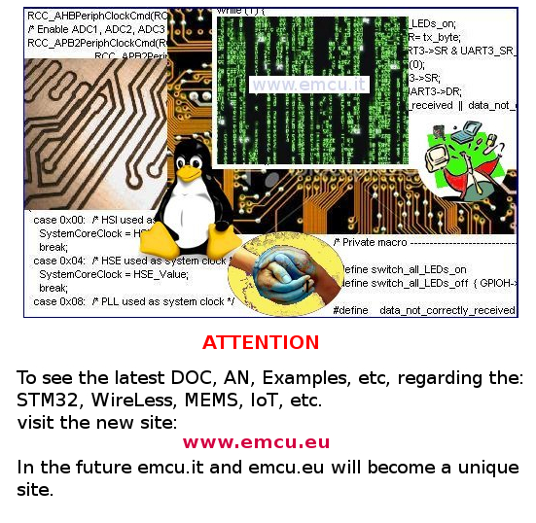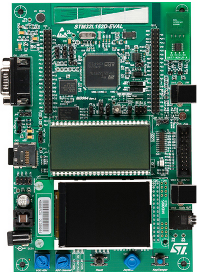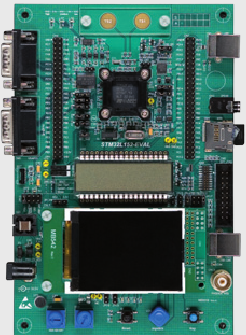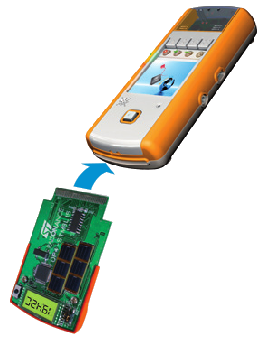

Home
Page
STM32 Page
INTRODUCTION
Supply monitoring and resets




Power-Saving Features and Benefits
STM Class B norm certification self‐test routines:
STM Touch-Sensing Library
In general Software Resources are here:
Tutorial
Evaluation Board
STM32L152D-EVAL Evaluation board for STM32L1 series - with STM32L152ZD MCU
STM32L152‐EVAL
STM-PRIMER
STM32 Page
INDEX
STM32L official page: http://www.st.com/internet/mcu/subclass/1376.jsp
Introduction
Portfolio
Differences from STM32L15x and STM32L100
Power-saving features and benefits
Library
Application Notes, Manuals, etc
Development and Programming tools
Tutorial
Evaluation Board
STM32Lxxx MKT presentation Mar.2013
Introduction
Portfolio
Differences from STM32L15x and STM32L100
Power-saving features and benefits
Library
Application Notes, Manuals, etc
Development and Programming tools
Tutorial
Evaluation Board
STM32Lxxx MKT presentation Mar.2013
INTRODUCTION
The STM32Lxx series, based on the Cortex-M3 core running at 32 MHz, extends the ultra low power portfolio in performance, features, memory size and package pin count.
The STM32Lxx series combines performance and ultra low power consumption, using optimized architecture and our proprietary ultra low leakage process, shared with the STM8L family.
The STM32Lxx series is available in two different lines (STM32L151 and STM32L152), so optimizing the STM32F and STM8L families for many applications requiring performance with special care on power savings.

The STM32Lxx series combines performance and ultra low power consumption, using optimized architecture and our proprietary ultra low leakage process, shared with the STM8L family.
The STM32Lxx series is available in two different lines (STM32L151 and STM32L152), so optimizing the STM32F and STM8L families for many applications requiring performance with special care on power savings.
- Lowest power mode: 0.27 µA
- Dynamic run mode: 230 µA/MHz

- ARM Cortex‐M3 32 MHz CPU
- 32 to 384 KFlash, up to 48 KSRAM
- and up to 12 KEEPROM
- Three lines: pin‐to‐pin, software and peripheral compatibility
- Pin‐to‐pin compatibility with STM32F series (except VBAT not present on the STM32L)
- Ultra‐low energy consumption: down to 180 μA/DMIPS from Flash
- Supply voltage: 1.65 to 3.6 V
- Six ultra‐low‐power modes: down to 300 nA
- Ultra‐low‐power dynamic modes: low‐power run down to 9 μA; low‐power sleep down to 4.9 μA with one timer
- Economical Run mode consumption down to 230 μA/MHz from Flash at zero‐wait state with dynamic voltage scaling (3 ranges)
- Rich set of high‐end analog and digital peripherals
- ‐40 to +105 °C operating temperature range
- STM32L151 standard family
- STM32L152 has an additional LCD-segment driver
- STM32L162 embeds a 128-bit AES
Supply monitoring and resets
- Full reset circuitry, supply monitoring
Power‐on reset & Power‐down reset, permanently enabled (zero power)
Brown‐out detection (BOR) can be on or off in low‐power modes
BOR complies with all VDD rise/fall times, so no constraints on power supply shape.Programmable voltage detection can be on or off
When BOR is not activated, the STM32L starts at VDD = 1.65 V.
- Extended battery lifetime down to 1.65 V




Power-Saving Features and Benefits
The STM32L lines propose 6 different ultra‐low‐power modes to offer users a high level of flexibility depending on their application. In addition, the dynamic run consumption has been optimized.
Low‐power sleep mode:
Stop modes (2 modes):
Standby modes (2 modes):


Low‐power run mode:
CPU is still running
Execution is done from RAM with a low‐speed oscillator (RTC or internal)
Consumption is 9 μA typical
Execution is done from RAM with a low‐speed oscillator (RTC or internal)
Consumption is 9 μA typical
Low‐power sleep mode:
offers
the possibility of keeping the RTC and a few other peripherals active
(such as the timer) with a consumption of 4.9 μA typical with one timer
activated.
The Flash is switched off and the regulator is put into ultra‐low‐power, the CPU is stopped, the RTC and peripherals can be activated.
The Flash is switched off and the regulator is put into ultra‐low‐power, the CPU is stopped, the RTC and peripherals can be activated.
Stop modes (2 modes):
The CPU, main clocks and peripherals are off
The RTC can be on or off (2 modes)
Wake up can be done through an interrupt on the peripherals
SRAM and context are kept
The RTC can be on or off (2 modes)
Wake up can be done through an interrupt on the peripherals
SRAM and context are kept
Standby modes (2 modes):
The CPU, main clocks and peripherals are off
The RTC can be on or off (2 modes)
Backup registers are preserved
Wake up can be done through wake‐up pins
The RTC can be on or off (2 modes)
Backup registers are preserved
Wake up can be done through wake‐up pins


STSW-STM32077 - STM32L1xx standard peripherals library
STSW-STM32002 - Clock configuration tool for STM32L1xx microcontrollers
STSW-STM32081 - STM32F10x and STM32L1xx USB full-speed device library
Extra SW are available here and here
STSW-STM32002 - Clock configuration tool for STM32L1xx microcontrollers
STSW-STM32081 - STM32F10x and STM32L1xx USB full-speed device library
Extra SW are available here and here
STM Class B norm certification self‐test routines:
a full set of ready to‐use self‐test
routines for home‐appliance certification under EN/IEC 60335‐1 Class B
norm (functional safety).
For Class B routine contact your STM local office.
For Class B routine contact your STM local office.
STM Touch-Sensing Library
STMicroelectronics’
touchsensing software library is a complete, free-of-charge sourcecode
solution to transform any 32-bit STM32L microcontroller into a
capacitive touch-key controller.
This library controls the embedded charge transfer hardware driver, offers advanced filtering algorithms and touchkey management in various user cases.
Designers can combine the touch-sensing function with multiple configurations (touch keys, wheels, sliders) and the traditional MCU features (communication, LED control, beeper, LCD control).
This library controls the embedded charge transfer hardware driver, offers advanced filtering algorithms and touchkey management in various user cases.
Designers can combine the touch-sensing function with multiple configurations (touch keys, wheels, sliders) and the traditional MCU features (communication, LED control, beeper, LCD control).
In general Software Resources are here:
- Very low cost emulator is ST-Link-v2, see here for more info.
- C/C++ Compiler see:
- RTOS & Embedde Operating Systems and Firmware are here.
- Production programming solutions for ST ARM™ core-based MCUs are here.
Tutorial
- Dog & Cat automation for food and water using STM32L, all monitored via Internet
- Things to remember when you start a new project
- GPIO test for STM32L-Discovery
- LCD, SysTick and GPIO test for STM32L-Discovery
- STM32L-Discovery Timer Count Down
- STM32L Training - Attention: the STM32L Training is only for: STM registered customers.
If you is STM register customer download the files and ask to me the password for open it, remember to specify your STM-Customer-Registration.
Evaluation Board
STM32L‐DISCOVERY
is the cheapest and quickest way to discover the STM32L152RBT6 and its low-power capabilities.
It includes a 6‐digit LCD display, one touch-sensing slider, 2 LEDs, 1 user button, current measurement and the embedded debugger ST‐LINK-v2.

It includes a 6‐digit LCD display, one touch-sensing slider, 2 LEDs, 1 user button, current measurement and the embedded debugger ST‐LINK-v2.

STM32L152D-EVAL Evaluation board for STM32L1 series - with STM32L152ZD MCU
The
STM32L152D-EVAL evaluation board is a complete demonstration and
development platform for the STM32 L1 series of ultra-low-power MCUs
and includes an STM32L152ZDT6 ARM Cortex-M3 32-bit microcontroller with
384 KB of Flash memory. An ST-LINK/V2 is integrated on the board as an
embedded in-circuit debugger / programmer for the STM32L152ZDT6. The
full range of hardware features on the board helps you develop your own
applications and evaluate all peripherals (USB FS, USART, audio DAC,
microphone ADC, dot-matrix LCD, LCD glass, IrDA, LDR, SRAM, NOR Flash,
MicroSD Card, temperature sensor and so on).


STM32L152‐EVAL
Evaluation board with the STM32L152VBT6, implementing the full range of device peripherals and features.


STM-PRIMER
EvoPrimer components to build your own EvoPrimer for easy evaluation and development with STM32 and STM8 MCUs





